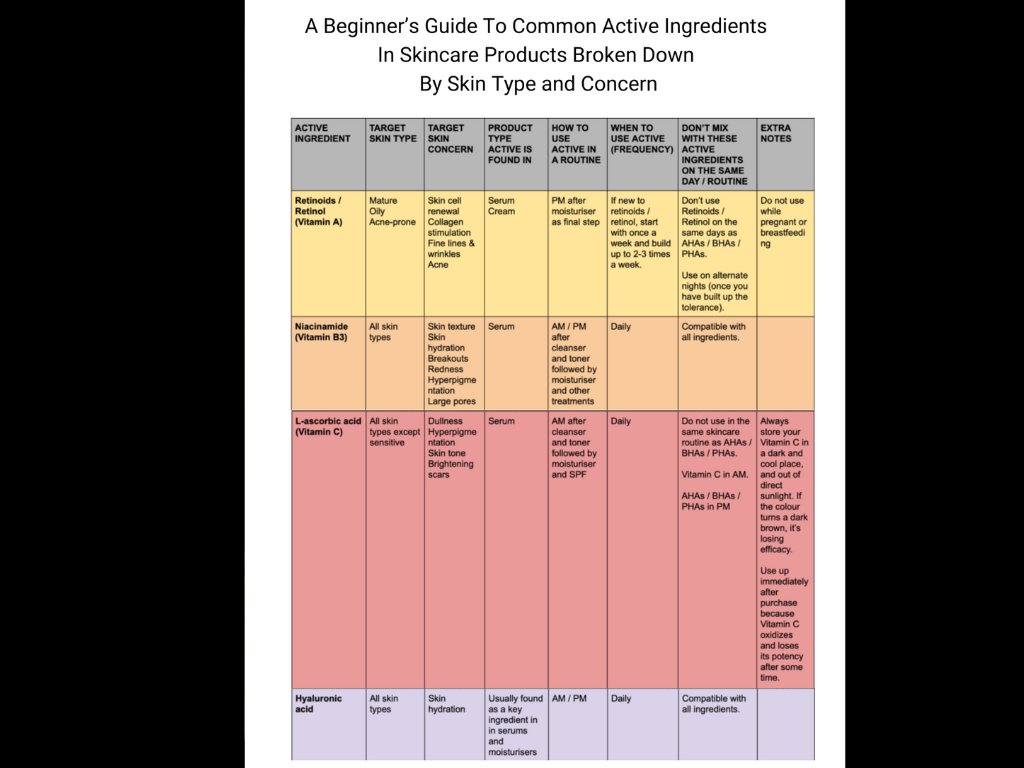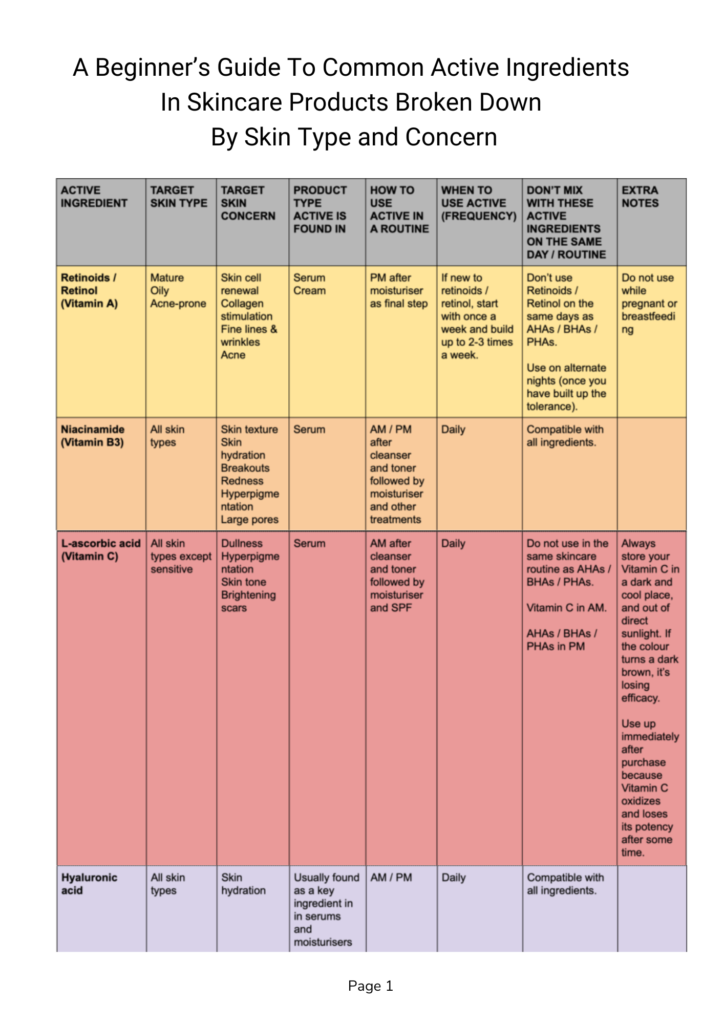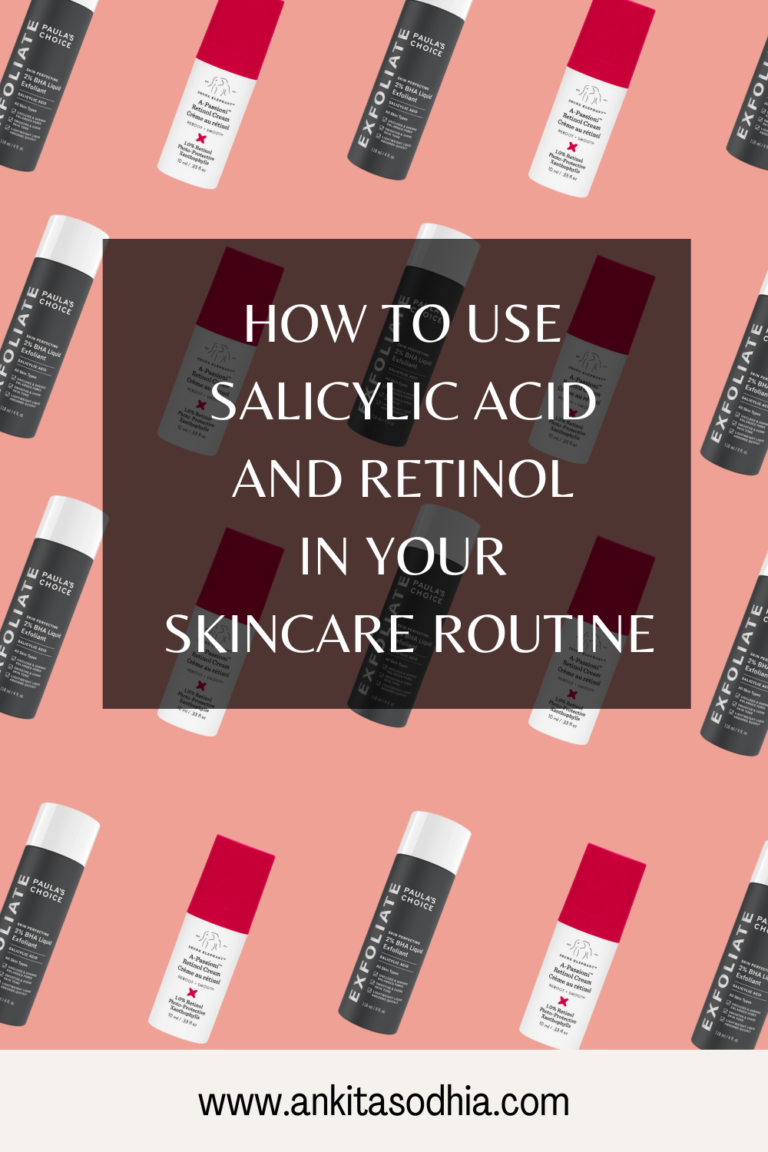A Beginner’s Guide To Skincare Active Ingredients In Products Broken Down By Skin Type and Concern (Includes a Printable Infographic!)

Are you new to skincare? This is the perfect starting point: here’s your beginner’s guide to popular skincare active ingredients broken down by skin type and concern.
Table of Contents
What is a skincare active ingredient?
I want to clarify that when I say ‘active ingredients’ I am referring to a key ingredient in a product, which is designed to work on a certain skin concern. For example, the active key ingredient in my daily serum after I cleanse my face is Vitamin C and its role is to help brighten complexion and help fade scars. The serum itself has lots of other ingredients but the one to keep an eye on is the key “active ingredient”, which is usually mentioned on the front of the product packaging.
Focusing on the ingredients in skincare products (rather than just going by the marketing lingo and product claims) has really helped to understand how different products actually work, how to properly use them in a skincare routine and, most importantly, judge if they make sense for me and my skin concerns.
Before starting anything — do you know what your skin type is?
Before even diving into specific ingredients and products, I can’t stress enough the importance of doing the due diligence of understanding your own skin to truly know what skin type you have and what your skin concerns are. If you spend the time to study your skin and really get to know it, then I promise the information below will be much more valuable and actionable.
Please note: I am not a doctor and all the information below is for illustrative and informational purposes only. Please consult your doctor before starting any new skincare products.
Skin types
So let’s discuss the main different skin types and general characteristics of each:
Dry: tends to be flaky and dry, appearance of fine lines, small pores, easily irritated
Sensitive: can be oily or dry, reactive and easily irritated to internal or external factors, , redness, burns and itches sometimes
Normal: balanced (not oily or dry), non-sensitive, smooth
Combination: dry in some areas, oily in some areas, breaks out easily, larger pore size
Oily: prone to breakouts, appears oily (especially in the T-zone), enlarged pores
Mature: dry, lack of luminosity, deep fine lines and wrinkles, open pores, lack of tone and firmness
Note: It is possible to have one or two more of the skin types listed.
Skin Concerns
Acne / blemishes: pimple breakouts and scarring
Dryness / dehydration: dry skin, itchiness, flaking, tightness
Uneven skin tone / hyperpigmentation / dark spots / dullness: freckles, age spots, sun spots, melasma etc
Lines and wrinkles: deep lines such as smile lines, creases in the forehead (this can occur in our 20s and 30s)
Signs of ageing: dull skin, fine lines, wrinkles
Texture: roughness and bumpy texture, enlarged pores
Sensitivity: easily irritated, redness, reactive (both skin type and concern)
So hopefully you’ve figured out the skin you’re in and we can move forward to looking at different active ingredients in skincare products and how they can help your specific skin type and concerns.
This is not an exhaustive list by any means. In the interest of keeping it digestible for beginners, here are the most common skincare active ingredients, which I think are important to know about. They also target more most of the skin types and concerns mentioned above.
Categories of skincare active ingredients
Skincare active ingredients are generally separated into three main categories. Please refer to the table below to learn which products to find these ingredients in and how best to use them.
1. Vitamins
Vitamin A (retinoids / retinol / Retin-A)
Retinoids is a class of ingredients that promotes healthy skin cell production, skin cell renewal and collagen production. Vitamin A helps to keep skin firm and healthy and it is available in an over-the-counter version in lower concentrations called “retinol”, which is an ingredient often seen in skincare products in stores. You might also see “Retin-A” or “tretinoin”, which is a prescription-grade version of retinoid prescribed by doctors. In general, retinoids are a strong active ingredient and need to be used with caution. For beginners start with once a week and slowly build up to two or three nights a week (alternating nights).
Vitamin B3 (niacinamide)
A derivative of vitamin B3, niacinamide helps to reduce inflammation and redness from conditions such as acne and eczema. It also helps the skin retain moisture, minimize enlarged pores, soften fine lines and improve skin texture. Niacinamide is a non-irritating active ingredient that works well with most skin types. Can be used daily AM / PM.
Vitamin C (ascorbic acid also known as L-ascorbic acid)
Vitamin C is a very popular skincare active ingredient because it helps brighten and even out skin tone, diminish scars and dark spots, and reduce the appearance of fine lines and wrinkles. It is also a potent antioxidant and protects the skin against pollution and free radicals. Vitamin C serums are abundantly available and easy to use. Start slow by using once or twice a week to be sure you have no sensitivities and then it can be used daily in the mornings. Always follow up with SPF.
Related:
A Beginners Guide: What Is Retinol and How To It In A Skincare Routine
Why You Need A Vitamin C Serum In Your Morning Skincare Routine — And Beginner Tips To Get Started
Can You Use Niacinamide And Vitamin C Together? Everything You Need To Know
2. Acids
Hyaluronic acid
Occurs naturally in skin and holds up to 1000x its weight in moisture. It is a ‘humectant’ unlike the other acids mentioned below, which are used for chemical exfoliation. Hyaluronic acid is a very popular and effective active ingredient in a lot of products as it helps the skin retain moisture, stay hydrated, look plump and feel supple. It is often found in moisturizers and used as the last step in skincare routine because it helps the skin lock-in moisture.
Alpha Hydroxy Acids (AHAs)
This is a category of naturally occurring acids found in organic sugars, milk and sugary fruits, which are used as sources for active ingredients in skincare. Since AHAs are water-loving molecules, they offer hydrating and skin plumping benefits. It is important to note that since AHAs work on the surface of the skin, it does make the skin sensitive to the sun and an SPF is always required when using AHAs in a skincare routine.
The main purpose to include an AHA into your skincare routine is for chemical exfoliation — the process of using a toner or peel to remove dead skin cells so that skin texture appears smoother and clearer. There are a few different kinds of AHAs to be know about:
- Glycolic acid: Derived from sugar, glycolic acid has the smallest molecules and penetrates the skin to work on the top layer as well as deeper. It works best as an exfoliant to remove dead skin cells, leaving behind brighter, smoother skin. Glycolic acid also promotes collagen production, which improves skin elasticity and reduces the appearance of fine lines and wrinkles. Best suited for normal, combo, oily skin types. Avoid if you have dry, sensitive or reactive skin. Look for pH levels of 3.5-4 in skincare products for most effectiveness. Start slow — once a week and build up to two-three times a week.
- Lactic acid: Derived from dairy, lactic acid works in a similar way to glycolic acid to work on the top layer of skin as well as deeper. It has slightly larger molecules than glycolic acid so it does not penetrate the skin as deeply, making it milder as well. It works best as an exfoliant to remove dead skin cells, add hydration and improve acne scars and bumps. While normal, combo and oily skin types can use lactic acid, it is better suited for dry, sensitive and acne-prone skin types. Look for lactic acid products with concentration of 10% or less and a pH of around 3.5 to 4. Start slow — once a week and build up to two-three times a week.
Beta Hydroxy Acid (BHA)
This is a category of oil-loving acid molecules, which penetrates deeper into pores to dissolve dead skin cells, blackheads and excess sebum. BHAs offer anti-inflammatory and antibacterial benefits, making it suitable to those with oily and acne-prone skin and skin concerns such as acne and rosacea. It does not make the skin sensitive to the sun. The main BHA to know about:
- Salicylic acid: Derived from natural sources such as willow tree bark, wintergreen leaves or sweet birch bark, salicylic acid is the most popular and widely used BHA in a lot of skincare products. Salicylic acid works by penetrating the pores to break the bonds in the pore lining where cells stick together i.e. unclogging pores to let oils flow out easily so it can be cleansed away. By clearing out pores of excess sebum and debris, salicylic acid helps to make pores appear small and keep the skin clarified from within, reducing the chance of future breakouts. Using salicylic acid in a leave-on toner form with a pH of 3.5 to 4 and concentration of 1-2% is the most effective way to enjoy its exfoliating benefits. Start slow — once a week and build up to two-three times a week. Do not use salicylic acid if you are pregnant, breastfeeding or have an allergy to aspirin.
Polyhydroxy Acids (PHAs)
PHAs are known as the “new age cousins of AHAs”. Similar to AHAs, PHAs are water-loving molecules so they work to add hydration and plump the outer layer of the skin. The main difference between AHAs and PHAs is that PHAs have a larger molecular structure, which means they work primarily on the outermost layer of the skin and do not penetrate the skin as deeply as AHAs, making it gentle enough and suitable for those with extra dry or sensitive skin. Look out for popular PHAs gluconolactone, galactose and lactobionic in products. Start slow — once a week and build up to two-three times a week.
How To Use Salicylic Acid And Retinol In Your Skincare Routine
3. SPF
SPF: SPF stands for ‘sun protection factor’ and refers to how well a sunscreen will protect the skin against harmful UVA and UVB rays, which can cause ageing, sun spots, fine lines and wrinkles, dull complexion and skin cancer. It’s important to note that UV rays can still penetrate the skin on even cloudy days and while being indoors, so using a product with a broad-spectrum sunscreen rated SPF 30 or higher is essential every single day. Sunscreen also helps to protect the skin against sensitivities from skincare treatments such as AHAs, retinoids, and vitamin C pollution as well as free radicals and pollution. There are two types of sunscreen products to be aware of — chemical and physical sunscreens — and it’s really up to you which one you prefer:
Chemical sunscreen
Chemical sunscreens contain ingredients such as oxybenzone, octinoxate, octisalate, and avobenzone, which work by a chemical reaction in which any UV rays hitting the skin are absorbed and changed into heat and then released from skin. In general, chemical sunscreens tend to be thinner, cause no white cast, easier for daily use and wear well under makeup. Might be irritable for sensitive skin types. Keep a lookout for chemical sunscreens that are reef-safe. Do not use chemical sunscreens while pregnant or breastfeeding.
Physical (mineral) sunscreen
Physical sunscreens contain mineral ingredients such as zinc oxide and titanium oxide, which sit on top of the skin to deflect and scatter UV rays from penetrating i.e. physically blocking the UV rays. In general, mineral sunscreens tend to be thicker, can cause white cast (especially on dark skin tones), can clog pores and require more time to fully blend into the skin. It is better suited for those with sensitive / reactive skin type and skin concerns such as rosacea and redness. Suitable while pregnant or breastfeeding.
Now that we’ve covered skin types, skin concerns and active ingredients, it’s important to know how to choose products and create a skincare routine that works for you. It doesn’t mean going on all-in and using everything at once — be mindful and careful about how you use products.
That’s why I have put together the table below to further explain how each active ingredient works by skin type and concern and how to use it in a skincare routine.
Please note: I am not a doctor and all the information below is for illustrative and informational purposes only. Please consult your doctor before starting any new skincare products.
Printable Guide For Skincare Active Ingredients
Download the PDF version here.
I hope you found this post useful. If you have any specific questions, feel free to email or DM me on Instagram (@ankitasodhia).








Thanks for sharing this really comprehensive overview. Love the handy printable chart.
Thank you so much! I’m very happy you found it helpful and comprehensive 🙂
This is so great! I’m going to add a link to your post in my skincare blog on Enliven 🙂
Glad you like it and thank so you much for sharing 🙂